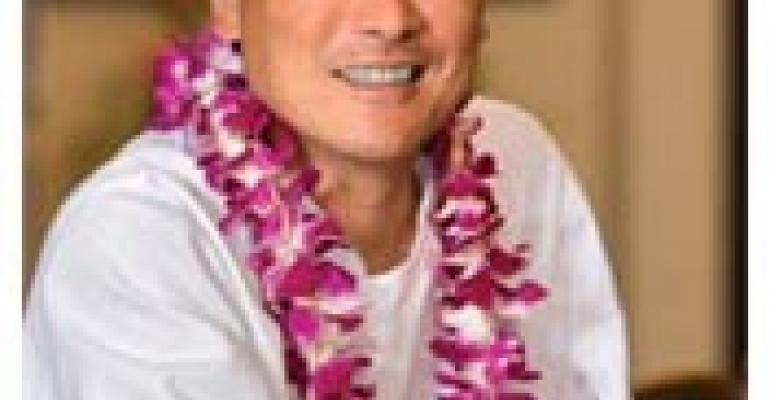
Roy Yamaguchi introduced the world to Hawaiian fusion cuisine when he opened the first Roy's in 1988. Now with three dozen restaurants, Roy's extraordinary service, quality and value continue bringing in the customers, even in difficult times. Yamaguchi inspires loyalty and leadership in his chef/partners. Each chef is encouraged to showcase his or her own creativity while producing Roy's signature dishes, including Maui Wowie Shrimp Salad, Hawaiian Style Misoyaki Butterfish or Crunchy Golden Lobster Pot-stickers. And the recipes for these “craved” dishes can be found in his four gorgeous books, including the latest, Roy's Fish & Seafood. Yamaguchi chatted recently with RH contributor Libby Platus.
RH: What is Hawaiian fusion?
Yamaguchi: Three things belong to Hawaiian fusion: fresh ingredients from local sources; mainly seafood, but not necessarily, because we have a lot of steaks and chicken; and bold Asian flavors. I was born in Japan, so I use Japanese techniques or styling. Also, I love French cooking and use a lot of French sauces.
RH: One of your special events showcased eight Hawaiian fusion flavors: Hawaiian sea salt, passion fruit, lemongrass, ti leaf, orchid, kumquat, Japanese green onion and galangal. Are these the main flavors of your cuisine?
Yamaguchi: No. We don't have a small number of ingredients. We have many, and they vary from dish to dish. I'm not going to use passion fruit for a sauce on a fish but will use it for a nice hopia dessert — hopia is coconut — or a marinade for lamb or maybe a venison dish or pork. I use Hawaiian salt with many things, but I do not put it on a lot of fish. It's a stronger salt with more of a bite, and becomes too crunchy for the fish, especially if it is a soft fish.
RH: You are one of the founders of Hawaiian regional cuisine. What is it?
Yamaguchi: Hawaiian regional cuisine isn't a cuisine. It is a group of chefs getting together and forming a pact to utilize fresh Hawaiian products.
RH: Where do you get your inspiration?
Yamaguchi: I get inspired every day. I get inspired by waking up, driving to work, watching a basketball game, anything. I get inspired by just sitting down. An idea will just happen. I'll be doing something and all of a sudden, boom! The light clicks on.
RH: You had a very successful PBS TV show. Do you have plans for more?
Yamaguchi: Most likely not. I'll be honest: I'm not a TV guy. I don't care to be in front of the cameras. It doesn't really excite me.
RH: What do you like about the culinary tours you lead?

Yamaguchi: We just went to Croatia. We've been to Egypt and South Africa, and this year we're heading to Japan and Istanbul. I love to do it because our guests want to come with us. It's a chance for everyone to learn more about food. And I learn about cooking techniques, spices, herbs and flavors.
RH: With books, TV, culinary travel and restaurants, how do you manage your time?
Yamaguchi: I don't divide my time, specifically. I just do what I do at any given moment. If I have a half-hour to spare, if I'm waiting for the bus or something, maybe I'll work on a recipe or a thought process. It's not a question of whether I plan things out.
RH: Where do you like to eat?
Yamaguchi: Nobu Matsuhisa has restaurants everywhere, and he's one of my best friends. And I love to eat at Alan Wong's Restaurant in Hawaii.
RH: From time to time Roy's features special theme events, like Roy's Island Hop. The brochure announcing this event highlights several participating Roy's chefs and the dishes they have created for the occasion. How does this fit with your organization's goals?

Yamaguchi: Our original menu was made by a group of chefs in Hawaii Kai's kitchen. Our chefs continue to grow our brand and to personalize who we are.
RH: Must a dish sustain a certain level of sales to stay on the menu?
Yamaguchi: Not at all. It's not a question of sales. It's a matter of how the guests receive it and what they think of it. Sometimes I'll keep something on a menu for a long period if I feel it really represents who I am. It might sell only one or two a night.
RH: How do you train your chefs?
Yamaguchi: Gordon Hopkins, one of my partners and our original chef, has always helped me inspire and nourish our chefs. And I have David Abello, who has been with me for about 18 years. Gordon, David and I go around and work with our people and give them ideas.
RH: Catering to children is paramount at the Woodland Hills Roy's. The belief is, if children are happy, they'll bring the adults back. The staff is encouraged to go beyond what most restaurants do to make children happy. Children get a tour of the kitchen, with special attention to the desserts. Their orders come out first. And all get a gift from the treasure chest. Is this the approach at all your units?
Yamaguchi: We started this process at the original Roy's. Hawaiians take care of families. Kids are the future for life and, also, the future of business. We make it an environment for them to learn about food. We want to be sure to give them something like a nice hibachi salmon. We provide a kid's quesadilla to start and a special menu. The treasure chest rewards them for coming to the restaurant and encourages good behavior.





